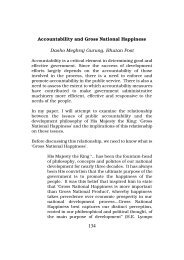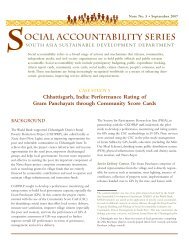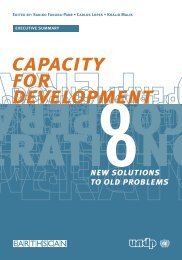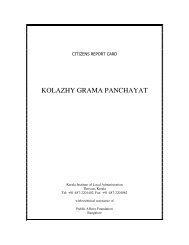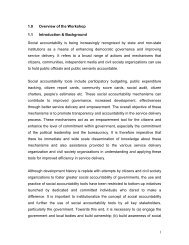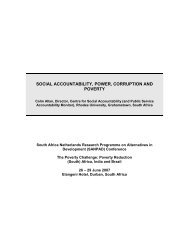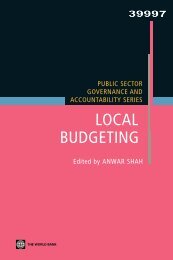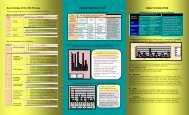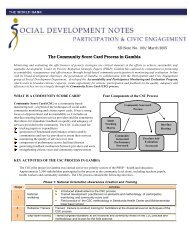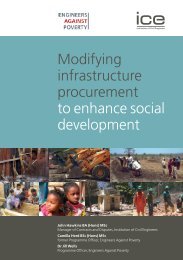Enabling Environment for Social Accountability in ... - SASANet
Enabling Environment for Social Accountability in ... - SASANet
Enabling Environment for Social Accountability in ... - SASANet
Create successful ePaper yourself
Turn your PDF publications into a flip-book with our unique Google optimized e-Paper software.
Ga<strong>in</strong><strong>in</strong>g access to budgets is a critical first step <strong>in</strong> address<strong>in</strong>g compla<strong>in</strong>ts about the mismanagement of<br />
resources to public schools. In one <strong>in</strong>stance, local officials allegedly colluded with those deliver<strong>in</strong>g<br />
heat<strong>in</strong>g fuel to schools to supply less than the amount budgeted but then charge the full amount, and<br />
pocket the rest. 83 Accord<strong>in</strong>g to the pr<strong>in</strong>cipal, however, the funds that were “skimmed” off were used to<br />
cover teachers’ salaries. Regardless of the accuracy of the allegations, they <strong>in</strong>dicate a need <strong>for</strong> greater<br />
transparency and local <strong>in</strong>volvement <strong>in</strong> the management of schools.<br />
The Asian Development Bank (ADB) is implement<strong>in</strong>g a Public Adm<strong>in</strong>istrative Re<strong>for</strong>m Program to assist<br />
educational <strong>in</strong>stitutions to adhere to the Public Sector Management and F<strong>in</strong>ance Law adopted <strong>in</strong> 2002.<br />
The ADB’s focus is on budgetary bodies and public <strong>in</strong>stitutions, as opposed to the participation of local<br />
communities or CSOs <strong>in</strong> budget <strong>for</strong>mulation or monitor<strong>in</strong>g. Moreover, various stakeholders, <strong>in</strong>clud<strong>in</strong>g<br />
education specialists, noted that the PSMFL has re<strong>in</strong><strong>for</strong>ced upward rather than downward accountability<br />
to <strong>in</strong>stitutions such as school councils and local communities (F<strong>in</strong>d<strong>in</strong>g EDU 6). This trend is reflected <strong>in</strong><br />
the reduced role of school councils.<br />
THE LOCAL INITIATIVE FUND: A COMMUNITY INITIATIVE?<br />
The Uyanga school was selected <strong>for</strong> this study from among a group of schools that have received fund<strong>in</strong>g<br />
from the Local Initiative Fund. 84 A key goal of LIF is to “facilitate community prioritization, selection,<br />
cof<strong>in</strong>anc<strong>in</strong>g, and execution of <strong>in</strong>vestments <strong>in</strong> basic <strong>in</strong>frastructure and social services provision” (World<br />
Bank 2005a). LIF provides f<strong>in</strong>ancial resources to bag and soum communities <strong>for</strong> a small-scale susta<strong>in</strong>able<br />
livelihood project to empower local governments For this reason LIF seeks to empower local government<br />
and communities and strengthen their capacity to improve the potential <strong>for</strong> susta<strong>in</strong>able livelihoods by<br />
mak<strong>in</strong>g f<strong>in</strong>ancial resources available to bag and soum level communities <strong>for</strong> a small-scale susta<strong>in</strong>able<br />
livelihood project that they deem to be their highest priority. Priorities are identified at a bag-level<br />
meet<strong>in</strong>g and then voted upon by the soum khural. The decision is <strong>for</strong>warded to the aimag khural and<br />
ultimately to the LIF project office <strong>in</strong> Ulaanbaatar that coord<strong>in</strong>ates these projects.<br />
The LIF project is be<strong>in</strong>g conducted as a pilot <strong>in</strong> Bayangol, a duureg (neighborhood) <strong>in</strong> Ulaanbaatar, and<br />
<strong>in</strong> 8 aimags (prov<strong>in</strong>ces), where 143 soums (districts) were <strong>in</strong>itially eligible to receive grants of up to<br />
$8,000, subsequently raised to $16,000 <strong>in</strong> January 2005. With the exception of Bayangol, LIF targets<br />
mostly rural areas. A LIF project can fund anyth<strong>in</strong>g that is not on a “negative list.” 85 As of January 2005,<br />
however, more than 730 projects had been approved to enhance the <strong>in</strong>frastructure of educational<br />
<strong>in</strong>stitutions, represent<strong>in</strong>g approximately 60 percent of the total number of grants awarded. In addition to<br />
enhanc<strong>in</strong>g local control over public resources, these education-related LIF projects enhance community<br />
<strong>in</strong>volvement <strong>in</strong> Mongolian schools and empower school councils. The evidence from the Uyanga school,<br />
however, suggests that this potential is not be<strong>in</strong>g realized.<br />
Accord<strong>in</strong>g to the local SLP secretary <strong>in</strong> Uyanga soum, meet<strong>in</strong>gs were held <strong>in</strong> the local bags to identify<br />
priority sectors <strong>for</strong> LIF fund<strong>in</strong>g. After the bags identified education as the priority <strong>for</strong> LIF fund<strong>in</strong>g, the<br />
school authorities selected the actual project. However, parent representatives on the local school council<br />
who were questioned about this, were un<strong>in</strong>volved <strong>in</strong> the process and unaware that their school had even<br />
received fund<strong>in</strong>g from the LIF program (F<strong>in</strong>d<strong>in</strong>g EDU 7).<br />
83 Heat<strong>in</strong>g and electricity costs account <strong>for</strong> 20 percent of the money spent on education <strong>in</strong> Mongolia (World Bank 2002c).<br />
84 LIF projects are a component of the World Bank-f<strong>in</strong>anced Susta<strong>in</strong>able Livelihoods Project, funded through an International<br />
Development Association loan.<br />
85 The negative list <strong>in</strong>cludes projects that would benefit only a few households, may have a negative environmental impact or<br />
social consequences, or are f<strong>in</strong>anced by another World Bank project or fund<strong>in</strong>g source.




